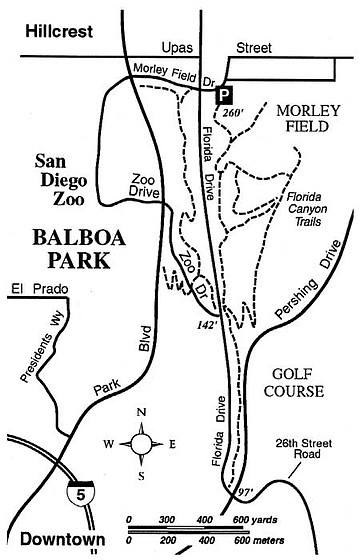 Facebook
Facebook
 X
X
 Instagram
Instagram
 TikTok
TikTok
 Youtube
Youtube
Balboa Park has plenty of "tame" places to walk, such as landscaped sidewalks on the grassy west side, paved trails inside the San Diego Zoo, and a number of semiwild trails in canyon bottoms near the museums. But in the park's lesser-known eastern section, centered on Florida Canyon, you can find about four miles worth of relatively primitive trails for use by hikers, runners, birdwatchers, wildflower gazers, and mountain bikers.
Of course, the natural vegetation of Florida Canyon -- classified mostly as coastal sage scrub but with plenty of nonnative species mixed in -- may appear scruffy and desiccated by comparison with the lushly (and artificially) landscaped acres of Balboa Park proper. The aesthetic differences between the two sides of the park, however, will likely be minimized during the next three months, when the canyon sides wear a new coat of fresh green growth, wildflowers bloom, and the breeze bears the sweet/pungent scents of black sage and California sagebrush.
The principal starting point for the Florida Canyon trail system lies just west of the Morley Field athletic complex in the northeast corner of Balboa Park. At the trailhead parking lot you'll find a native plant demonstration garden, with a short trail looping through it. Nearby, there's a grassy space for dogs to roam. South of there, a somewhat intricate network of interconnecting trails clings to both sides of a wide ravine (called Florida Canyon), the floor of which is traversed by Florida Drive. That street may someday be permanently closed to automobile traffic at its northern end, an improvement for anyone using the trails and for the wildlife that maintains a tenuous existence in this minipatch of wilderness within the city.
Fashion your own route on the trail system, which contains interconnected pieces of old roads and trails. Though most of those pathways are easy to hike, several are technically challenging for mountain bikers. Be aware that -- depending on the level of trail maintenance and the amount of recent rain -- the trails can quickly get overgrown with brushy vegetation.


Balboa Park has plenty of "tame" places to walk, such as landscaped sidewalks on the grassy west side, paved trails inside the San Diego Zoo, and a number of semiwild trails in canyon bottoms near the museums. But in the park's lesser-known eastern section, centered on Florida Canyon, you can find about four miles worth of relatively primitive trails for use by hikers, runners, birdwatchers, wildflower gazers, and mountain bikers.
Of course, the natural vegetation of Florida Canyon -- classified mostly as coastal sage scrub but with plenty of nonnative species mixed in -- may appear scruffy and desiccated by comparison with the lushly (and artificially) landscaped acres of Balboa Park proper. The aesthetic differences between the two sides of the park, however, will likely be minimized during the next three months, when the canyon sides wear a new coat of fresh green growth, wildflowers bloom, and the breeze bears the sweet/pungent scents of black sage and California sagebrush.
The principal starting point for the Florida Canyon trail system lies just west of the Morley Field athletic complex in the northeast corner of Balboa Park. At the trailhead parking lot you'll find a native plant demonstration garden, with a short trail looping through it. Nearby, there's a grassy space for dogs to roam. South of there, a somewhat intricate network of interconnecting trails clings to both sides of a wide ravine (called Florida Canyon), the floor of which is traversed by Florida Drive. That street may someday be permanently closed to automobile traffic at its northern end, an improvement for anyone using the trails and for the wildlife that maintains a tenuous existence in this minipatch of wilderness within the city.
Fashion your own route on the trail system, which contains interconnected pieces of old roads and trails. Though most of those pathways are easy to hike, several are technically challenging for mountain bikers. Be aware that -- depending on the level of trail maintenance and the amount of recent rain -- the trails can quickly get overgrown with brushy vegetation.
